“If I had met St. Louis Grignion de Montfort five minutes before his death,” Dr. Plinio once said, “I would have knelt down, kissed his feet, and urged him: ‘Be even more devoted to Our Lady!’”1 The boldness of this exhortation, given to the greatest of Mariologists, presupposes a life of insatiable growth in love for Mary Most Holy…
Indeed, according to the majestic designs of Providence, the universal Mediatrix of all graces obtained for Dr. Plinio the gift of yearning for the sublime, especially in his devotion to her as Mother of mercy. This fervour had its dawn, went through countless trials, grew in fullness and now shines at its zenith at the feet of the Queen of Heaven.
What were the milestones of this journey? What was the culmination of this ascent?
A mother’s supreme teaching at her son’s dawning
So great is the mystery of motherhood that the Creator of the universe Himself wanted to have a Mother. And from then on, one of the main duties of mothers is to mirror the virtues of the Woman clothed with the sun (cf. Rv 12:1), chosen to give birth to the Sun of Justice.
Dona Lucilia’s affection, goodness and dedication were the first steps towards understanding Mary Most Holy for little Plinio
This splendour of the Virgin among virgins and Mother among mothers was faithfully reflected in Dona Lucilia, to whom Dr. Plinio was born. Already at the dawn of her son’s springtime innocence, she taught him to pronounce the Most Holy Names of Jesus and Mary, even before he could say “papa” and “mama,” thus introducing him to the atmosphere of the supernatural.
The unfailing kindness, enveloping affection, and selfless dedication that little Plinio experienced in Dona Lucilia were a stepping stone to understanding Mary Most Holy, as he would later affirm: “The fact that I felt my mother’s patience prepared me for something much greater: devotion to Our Lady. And when I pray the Salve Regina and the Memorare, I feel as if I am doing with her a little of what I did with my mother […], understanding that the supplication of the afflicted child is heard and that I can explain my problems to her with confidence, for I am never unwelcome.”2
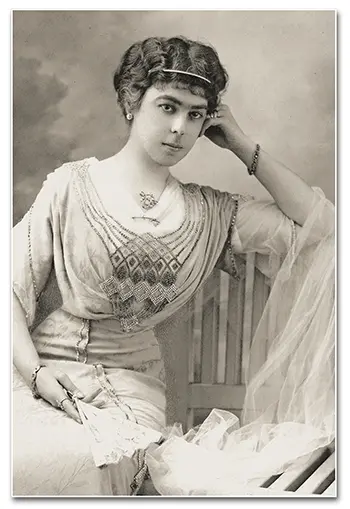
By the cross of trial… to the light of devotion!
When he was twelve years old, amid the difficulties he faced at school, Plinio went through a terrible trial, which would, however, be the cause of a huge step forward in his devotion to Our Lady.
Our Lady Help of Christians, smiling in the immobility of the marble, conveyed her forgiveness, kindness and tenderness to him, offering a covenant
Having always received top marks in behaviour, one day he found a six on his report card. Stunned, he decided to do himself justice and clumsily marked a ten on the card… His mother immediately recognized his writing and said: “I would rather have anything than a son who is a forger!” Threatened with being sent to a distant school in Minas Gerais, he ended his Saturday in sadness, slept in bitterness and went very early to Sunday Mass at the Sacred Heart of Jesus Shrine. Entering, he took refuge at the back of the aisle to his right, where a statue of Mary Help of Christians shone in snow-white splendour. Kneeling, he prayed the Salve Regina, changing the salutation into a shipwrecked man’s plea: “Save me, holy Queen!”
The Mother of mercy, smiling in the immobility of marble, made him feel her forgiveness, goodness and tenderness, and offered him a covenant, as if speaking to his soul: “I give myself entirely to you, but you must give yourself entirely to Me! Walk in faithfulness, say ‘no’ to the revolutionaries, so as to say ‘yes’ to Me, Queen of Heaven and earth. Fight and struggle, for one day you will see your ideals come true! Love Me all your life, and I will love you for eternity.”3 Promising never to forget that help and to be very devoted to her, Plinio replied in his heart: “My Mother, I am yours!”4
On Monday, the school principal confirmed the perfect score, and Dona Lucilia forgave her son. The severity of his earthly mother had been an act of mercy, which had lifted him up to his heavenly Mother. For the greatest strides in devotion to Our Lady are made when a person, begging for an extraordinary forgiveness or facing a tremendous hardship, prays to her and experiences her mercy, protection and desire to save.
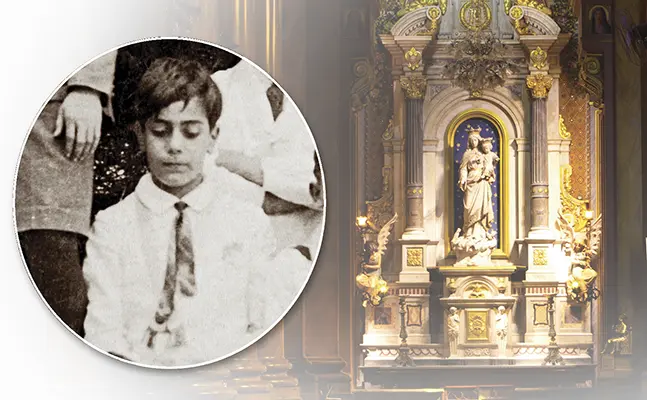
Slavery: a reality not yet explained, but already lived
Tested like gold in a crucible and purified by Our Lady Help of Christians, Plinio gained the strength to fight the Revolution. After beginning his membership in the Catholic Movement, he underwent six months of terrible trials. In this storm, a novena to St. Therese led him to the book of his life: True Devotion to the Blessed Virgin Mary, by St. Louis-Marie Grignion de Montfort.
While reading it, he found a theme never mentioned by anyone: the Reign of Mary, the goal toward which he was soaring. He admired the combatants called to establish this reign, as well as the height of holiness that would mark it as the pinnacle of history. He studied the book with transports of joy, but as one who had been thinking about such wonders since the episode of the “Save me, holy Queen!” To seal his surrender to the Blessed Virgin, he went to church and received Communion, then returned to his room, meditated, prayed the Veni Creator Spiritus and the Ave Maris Stella, and finally consecrated himself.
Throughout his life, in his thanksgiving after Communion, he would always implore Jesus for the fullness and summit of devotion to Mary, as far as human nature aided by grace would allow, with the aim of establishing the reign of Our Lady in souls and in the world.
The infallibility of prayer, guaranteed by the Redeemer (cf. Mt 7:7) and witnessed in its fruits by Dr. Plinio’s disciples, leads to the conclusion that he did, in fact, reach his utmost capacity to love the Mother of God.
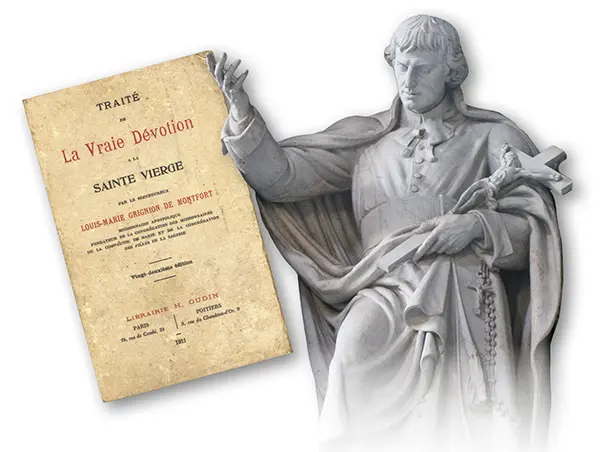
School to establish an order of chivalry
In St. Peter’s Basilica, a gallery of thirty-nine founders invites the faithful to raise their eyes to Heaven. The reason for this special honour is that founders receive the gift of inspiring not only individuals or a group, but a veritable host called to spread the charism granted to them.
Having consecrated himself to Mary as her slave, Dr. Plinio implored God daily for the grace to attain the plenitude and apex of devotion to her
Seeing in Dr. Plinio the archetype and apostle of slavery to Mary, his disciples took him as their mediator and placed in his hands their consecration to her. The pioneer in receiving this inspiration, the young João Scognamiglio Clá Dias, would decades later found the Heralds of the Gospel, in whose charism the Treatise is a book of light, as it was for his master, who had conceived an order of chivalry based on the teachings of St. Louis Grignion.
Just as the best way to consecrate oneself to Jesus consists in slavery to Mary Most Holy, thought João, those who have Dr. Plinio as their father and founder should surrender themselves to Our Lady through him, in order to bring their obedience, service and praise to God to its peak.
If slavery is true devotion, then a marvel of grace imposes a prophecy on us: Reign of Mary… reign of slaves of Mary!
A counsel for a lifetime
In 1967, a diabetes crisis seriously affected Dr. Plinio’s health. He was not distressed by the prospect of death, but rather by the fear of seeing the prophecy of Scripture fulfilled: “Strike the shepherd, that the sheep may be scattered” (Zec 13:7). Leaving his mission incomplete was his sorrow. At the height of his anguish, he received a picture of Our Lady of Good Counsel, whose fresco is venerated in the city of Genazzano, Italy. A deep communication was established between them, and Our Lady, as if smiling, spoke to his heart: “My son, do not be troubled. Trust, because your work will be completed and you will fulfil your mission in its entirety.”5 He called this favour the grace of Genazzano.
In that suffering, could there have been a better counsel? No! As he repeatedly stated, the rest of his days were spent supported by the certainty of this supernatural help. A few years before ending his struggle on earth, he declared: “With so many concerns, if it were not for the promise of Genazzano, I would have died, for I could not have endured the uncertainties and doubts.”6
This mystical grace elevated his devotion to even greater heights. More arduous crosses and battles would come, conquests and victories would be more splendid. In return, his union with Mary would reach an ever greater fullness.
In his final days in 1995, despite being debilitated by the cancer that led to his death, Dr. Plinio continued to encourage everyone to devote themselves to Our Lady. One day, pointing to the picture of Our Lady of Good Counsel and clasping Msgr. João’s hand, he asked: “My son, look over there. Do you realize how much She loves you?” When he received an affirmative answer, he added: “You know how much I esteem you! Our Lady has given you so much!” And the faithful disciple, recognizing all he had received from his father and master, replied: “Yes, Our Lady has given me so much: She gave me you and She gave me Dona Lucilia. I want nothing more!” His encouragement had been reciprocated…
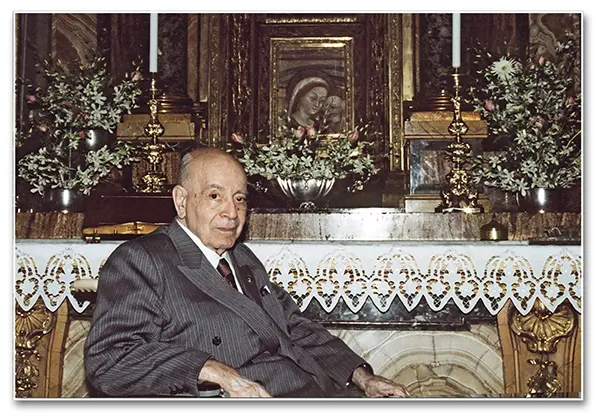
Thoughts of wisdom reveal the unfathomable nature of love
Who can measure the depth of Dr. Plinio’s love for the Blessed Virgin? For him, without Our Lady’s fidelity, the world would have ended after the deicide, such is her importance in the history of salvation. As the Woman of Genesis (cf. Gn 3:15) and of the Apocalypse, who opens and closes Revelation, reigning above time and place, She prevents humanity from rejecting the totality of the graces poured out on the children of Adam, gathering in herself, as Vas honorabile, the Creator’s designs in conceiving the universe.
He desired that his last words be a hymn of praise to the Blessed Virgin and to the Church: “a Roman Apostolic Catholic, a slave of Mary”
To glimpse her grandeur, let us think of all the wonders of the Church and Christianity summed up and distilled in her soul: “Considering the splendours of history, elevated to a peak never before reached, we can have some idea of who Our Lady is. Ark of the Covenant, She gathered what men have rejected and, as in the Book of Life, accumulates everything that is beautiful and good, great and true, in unimaginable proportions.”7 Would anyone be able to sound the depths and heights of history in this way without having seriously lived slavery to Mary?

We now understand better the advice that Dr. Plinio would offer to St. Louis: to grow even more in devotion to the Blessed Virgin. Insatiable in his devotion to the Queen of the universe, he lived it: “As I breathe my last breath, may my words be a hymn of love to Our Lady and to the Holy Church: a Roman Apostolic Catholic, a slave of Mary. Nothing else!”8
He always sought the sublime, the first élan of his soul, and in this upward impulse he obeyed St. Bernard’s “De Maria nunquam satis” (Of Mary, never enough). A Catholic man, he lived breathing Mary, as the world will live when her Immaculate Heart triumphs. ◊
Notes
1 CORRÊA DE OLIVEIRA, Plinio. Talk. São Paulo, 26/12/1994.
2 CORRÊA DE OLIVEIRA, Plinio. Notas autobiográficas [Autobiographical Notes]. São Paulo: Retornarei, 2008, v.I, p.71.
3 CORRÊA DE OLIVEIRA, Plinio. Notas autobiográficas [Autobiographical Notes]. São Paulo: Retornarei, 2012, v.III, p.196.
4 Idem, ibidem.
5 CORRÊA DE OLIVEIRA, Plinio. Conference. São Paulo, 26/4/1974.
6 CORRÊA DE OLIVEIRA, Plinio. Conversation. São Paulo, 16/8/1992.
7 CORRÊA DE OLIVEIRA, Plinio. Conference. São Paulo, 13/12/1977.
8 CORRÊA DE OLIVEIRA, Plinio. Talk. São Paulo, 14/3/1981.


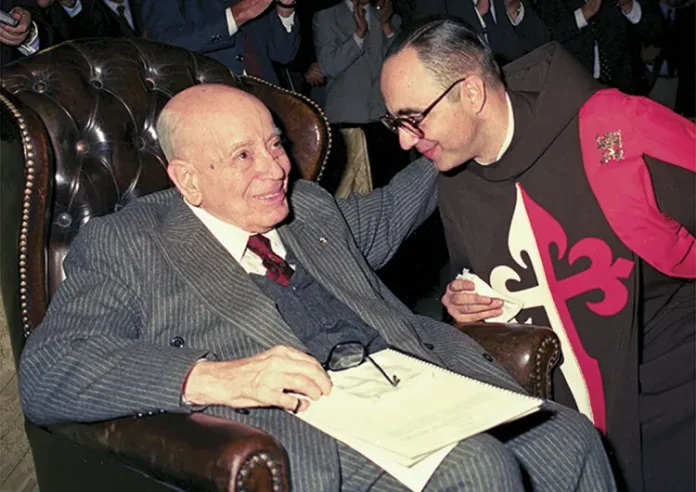
Breathtaking. May he be more honoured.